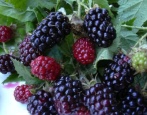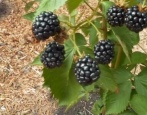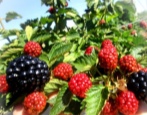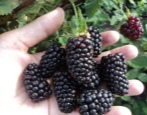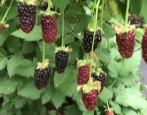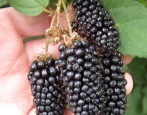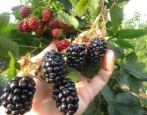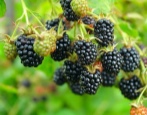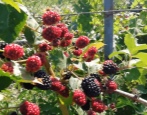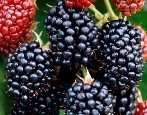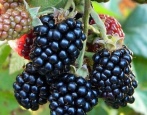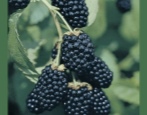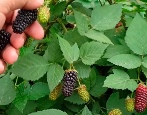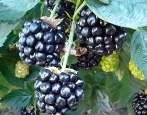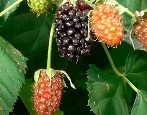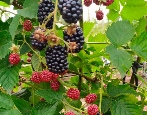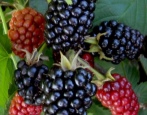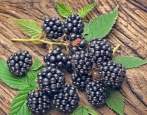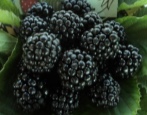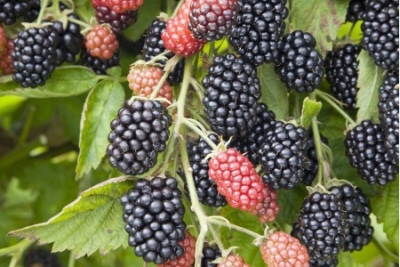
- Taste: sweet
- Scent : there is
- The presence of thorns: No
- Berry weight, g: 4-6
- Berry size: medium
- Berry color: purple
- Fruiting period: from mid-June
- Frost resistance, ° C / Winter hardiness: medium
- Watering: average
- Resistance to adverse weather factors: high
Blackberry Heaven can wait is capable of giving people a lot of pleasant surprises. However, it has some nuances of cultivation. It is worth considering both the timing of ripening and the choice of territory, its preparation, caring for plants.
Breeding history of the variety
Blackberry Heaven Can Wait has an alternative name - Heaven Can Wait. The development of the plant was carried out, as it is easy to understand, by foreign breeders. The American hybrid is still very young. It was introduced to the world in 2013 in Arkansas. Despite its "youth", the new culture is notable for its impressive popularity, but in Russia this hybrid is still very little widespread.
Description of the variety
You do not need to tie this blackberry. However, when growing in the shade, fertility will decline. The absence of thorns also testifies in favor of the plant. The disadvantages are the fragility of the inflorescences and susceptibility to rodent attacks. This is largely justified:
intensive growth of shoots;
self-pollination;
the suitability of the fruit for processing;
excellent resistance to anthracnose and rust contamination;
saturation of the fruit with vitamins and antioxidants.
Ripening terms
In official advertising, the emphasis is on very early fruit formation and low dependence on weather conditions. You can expect the berries to appear in mid-June (according to other sources, in mid-July). Blackberries begin to bloom in May. It is worth noting that gardeners must be patient - only by removing the berries that have ripened to the end can a positive effect be achieved. If they have just formed, disappointment is inevitable. Fruiting normally will last from 30 to 45 days.
Yield
Decent fertility is provided by powerful shoots reaching 2 meters or more vertically. However, the lack of practice hinders an accurate assessment of the amount of collection in domestic conditions. So far, we can only say that the fruits are more or less the same.
Berries and their taste
The mass of one berry can be from 4 to 6 g. Their surface is painted in purple tones. The pulp has a pleasant dense texture. The smell is there, but it is not very pronounced. The taste of a blackberry Heaven can wait at the same time sour and sweet, some tasters even declare that this is the most delicious variety in existence.
Basically, these blackberries are intended for immediate consumption. Storage, even in a refrigerator, for more than 5 days is not recommended. If you want to leave the crop for a longer period, it should be frozen. Harvesting is carried out when the berries have acquired a shine, but their flesh is still firm. Short-term storage is possible in a cool dry place.
Growing features
Site selection and soil preparation
For planting such plants, both acidic soil and soil of normal quality are useful. Black soil and sand can also be good options. A sunny or partially shaded area are ideal growing conditions.The gaps dividing the bushes should be from 1 to 1.5 m. It is imperative to choose dry land.
It is necessary to improve the composition of the soil in the fall. The introduction of humus and superphosphate plays a very important role. And also need potassium preparations. The size of the fossa on the plane is 50x50 cm. Its depth is determined taking into account the parameters of the plant's root system.
Pruning
Blackberry Heaven can wait to form in a horizontal pattern. The procedure must be carried out annually, since the culture is distinguished by active growth. Sick, deformed, and simply thickening shoots should be eliminated. Branches that have appeared in the current season are pinched to activate branching at the beginning of summer.
Watering and feeding
Heaven can wait - a comparatively drought-resistant plant. However, on hot days it is still necessary to water it. Intensive irrigation is also required against the background of flowering and during the formation of berries. Important: excessive watering is contraindicated. Heavily wetted soil will have an adverse effect.
Frost resistance and preparation for winter
The variety is characterized by medium cold resistance. Therefore, it is still better to cover it even in the middle lane. It is useful to play it safe in the southern regions. Agrofibre is considered the best covering material. The use of straw and spruce branches is possible, but this threatens the appearance of rodents, which is hardly useful.
Diseases and pests
The variety tolerates harmful influences quite persistently. However, this does not obviate the need for preventive treatments. Threats are anthracnose, powdery mildew, phylloxera and gray rot. Treatment with Bordeaux liquid in the form of a 1% solution helps to prevent their appearance. You need to use it in the near-stem circle before the kidneys appear.
Sometimes the bushes are treated with Trichodermin. The optimal concentration of the solution is 0.1%. There must be a 10-day pause between treatments. In some cases, 5% copper sulfate is also used for processing. Regardless of the chosen method of struggle, all affected shoots and leaves must be burned.
Reproduction
To spread blackberries Heaven can wait, it is best to use shoots. At the end of May or in the first decade of June, the branch is bent to the ground. In this position, it is fixed with staples and additionally sprinkled with soil. Rooting can be expected by the beginning of autumn. This is a signal that you can plant a crop in a permanent place.
